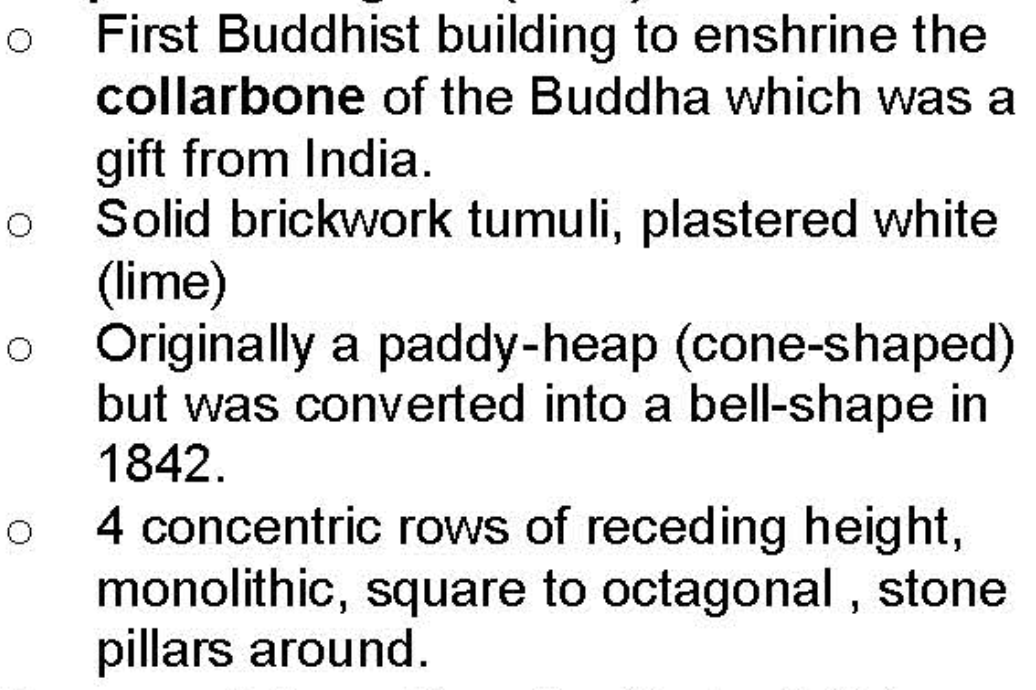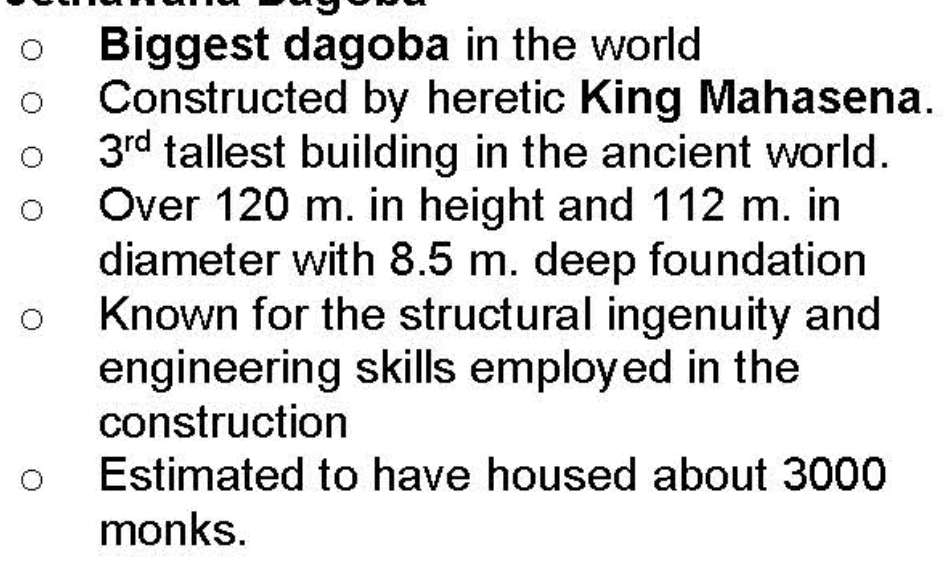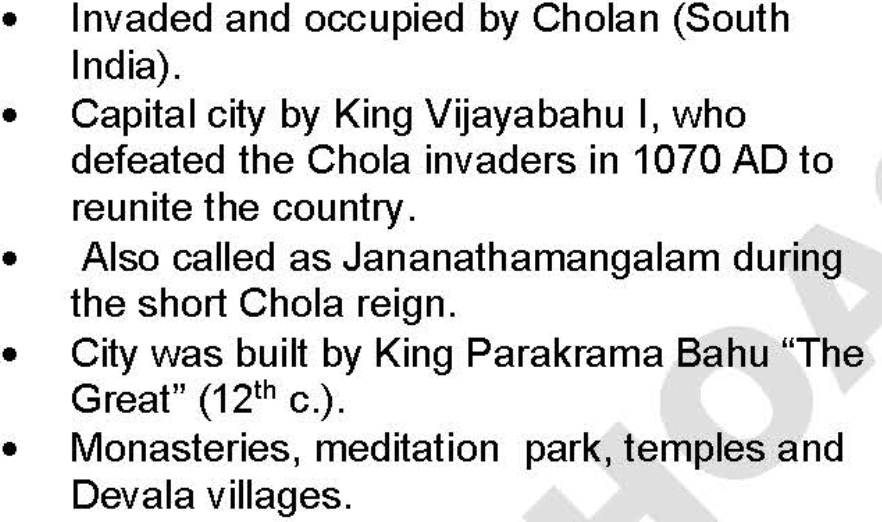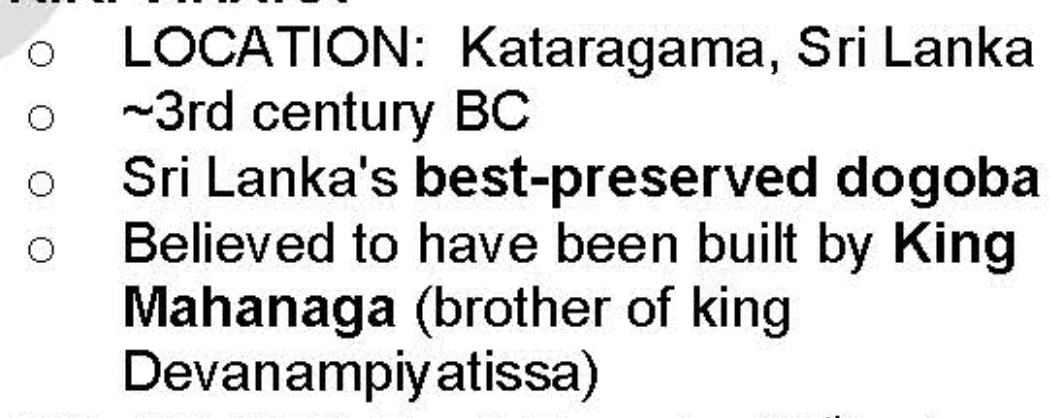HOA 3: MODULE 1 - SRI LANKA ARCHITECTURE
1/49
There's no tags or description
Looks like no tags are added yet.
Name | Mastery | Learn | Test | Matching | Spaced |
|---|
No study sessions yet.
50 Terms
Great Islamic gardens
Shalimar Garden in Lahore, one of the finest surviving ensembles
Humayun's Tomb
Built by the widow Hamida Banu Begum, for her deceased husband, nine years after his death.
1s example of Mughal architecture in India and 1st garden-tomb on the Indian subcontinent
The Lahore Fort (Shahi Qila)
Citadel complex started by Akbar
Located in the waled city of Lahore in Punjab,
Pakistan
21 notable monuments
Built almost entirely in the 17th century at the
height of the Mughal empire
Lahore
Royal (in Punjab)
Old Delhi Red Fort
Seat of the Mughal Empire
Huge, red sandstone walls, which stand 33 m.
high in some parts.
Walls were built to keep out invaders during
the reign of the Mughal Emperor Shah Jahan
in the reign of the Mughal Emnperor Shah Jahan
Ustad Ahmad Lahori
constructed the Taj Mahal
Diwan-i-Aam
Hall of Audience in the Red Fort; Where the emperors received members of the general public and heard their grievances
Jharoka
Marble canopies
Agra Fort
Foundation was laid by emperor Akbar in
1565 AD
Made of red-sandstone
Houses the Pearl mosque and Jahangir
Palace or the Khas Mahal, built by Shah Jaha
Taj Mahal (Palace of the Crown) of Agra
Erected by Shah Jahan in memory of his
beloved queen, Arjumand Banu Begum
Construction started a year after her death in
1631 and was complete in 22 years.
Palace of the Crown; Pearl of India
Mumtaz Mahal (Mausoleum)
Erected by Shah Jahan in memory of his beloved queen, Arjumand Banu Begum, called _______.
Charbagh
plan is entirely consistent and is known as a concept of garden design that first developed in Persia but was taken to an apex by the Moguls
Iwan
Two-storey passageway; Acts as a connection between the various parts of the bldg. or as an entrance
India
under the control of European colonial powers through trade and conquest.
INDO-SARACENIC
mixture of Hindu, Islamic and Western elements)
Se Cathedral
the cathedral of the Latin Church Archdiocese of Goa and Daman and the seat of the Patriarch of the East Indies
St. Francis Church
built by Portuguese in 1510, is considered as the first church built by Europeans in India
VICTORIA MEMORIAL
Location: Calcutta (Kolkata)
Built between 1906 and 1921 by the British government
Made of marble
Dedicated to the memory of Queen Victoria,
Empress of India from 1876 to 1901.
largest monument to a monarch
anywhere in the world
SANTHOME BASILICA
Location: Chennai (Madras)
National Shrine of St. Thomas
Parts of the present structure dates to 1523
AD, when it was rebuilt by the Portuguese
over the tomb of Thomas the Apostle
(Doubting Thomas)
Rebuilt by the British in the late 19th-century
style of Gothic Revival architecture
GREAT INDIAN PENINSULAR RAILWAY
Was incorporated on 1 August 1849
It was meant for the purpose of increasing
the export of cotton, silk, opium, sugar and
spices
Labeled as a Class I railway according to
Indian Railway Classification System of 1926
Chhatrapati Shivaji Terminus
Oldest train station in India; UNESCO WHS; designed by a British born architectural engineer Frederick William Stevens from an initial design by Axel Haig
Forest Research Institute
Dehradun, India
Greco-Roman Architecture
Designed by C.G. Blomfield
Main building was inaugurated in 1929 by then Viceroy Freeman Freeman-Thomas, 1st Marquess of Willingdon.
Festival of PERAHERA
devoted to the glory of the Warrior God, Skandha
Dharma-Dipa
the island of the Buddhist doctrine
ADAM'S PEAK
sacred mountain
Sree Padafoot (Sacred Footprint)
mark of Lord Shiva; For Buddhists, it is the footprint of Lord Buddha; Muslims and some Christians believe Adam first stepped down onto earth
DAGOBA

SARIRIKA
bodily relics of Buddha
PARIBOSIK
objects associated with the Buddha
Anuradhapura Period
First capital
Strategically situated (major ports in the
northwest and northeast; surrounded by irrigable and fertile land)
One of the most progressive centers of
political power and urban life in South Asia
SIGIRAYA
Ancient mountain fortress; City on a rock hill capital was built by Sinhalese King Kassapa I (477-95)
Sinhagiri (Lion Gate)
located a third of the way to the top; This is the Lion's platform with its giant lion paws
Thuparama Dagoba (3rd c)

Ruwanveli Saya Dagoba (2nd c B.C.)

ABHAYAGIRI DAGOBA
Founded as a vihara (monastery), in 88 B.C. by Sinhalese King Vattagamini.
Monumental structure 50 ft. higher than St. Paul's Cathedral
Jethawana Dagoba

Golden Temple of Dambulla
sacred pilgrimage site for 22 centuries.
cave monastery
comprises 5 sanctuaries with impressive
Buddhist mural paintings and 157 statues
Polonnaruwa Period ( 11th - 13 c AD)

Hydraulic engineering
construction of village water tanks, large reservoirs and irrigation canals.
KIRI VIHARA

GAL VIHARA Rock Temple (12th c. )
Also called Uttararama or rock monastery
Supreme achievement of Sinhalese sculptors.
Four colossal Buddha figures
carved out of rock, originally enclosed to form a shrine
Polonnaruwa Vatadage

vatadäge
type of Buddhist structure found in Sri Lanka; Also known as a dage, thupagara, or a cetiyagara. Circular relic-house; built in
stone and brick; Development of a STUPA
covered by a roof; Pillared building around a small STUPA provided with 4 entrances and 4
Buddha images placed at the cardinal points
sandakada pahana
also called a moonstone, this is an elaborately carved semi-circular stone slab, usually placed at the bottom of staircases and entrances
Kandyan Period (15th - 19th c AD)
Divided into several kingdoms with its capital at Kandy (Kandenuwara - hill city)
British
succeeded in annexing the Kandyan kingdom in 1815 until 1947 (Independence)
Maha Wasala
The King's Palace or Raja Wasala has:
Central gateway
hall resplendent with intricate stucco and terracotta embellishments
long wings flank either side, housing
chambers
Queen's Bathing Pavilion
is positioned south of the revered Temple of
the Tooth.
This was under the patronage of King Sri Wickrama Rajasinha, who designated it as a haven for his queens
Dalada Maligawa
Also called Temple of the Tooth
Oldest part shrine which stands in the
inner courtyard on high oblong stone
plinth carrying stone pillars with carved
wood capitals.